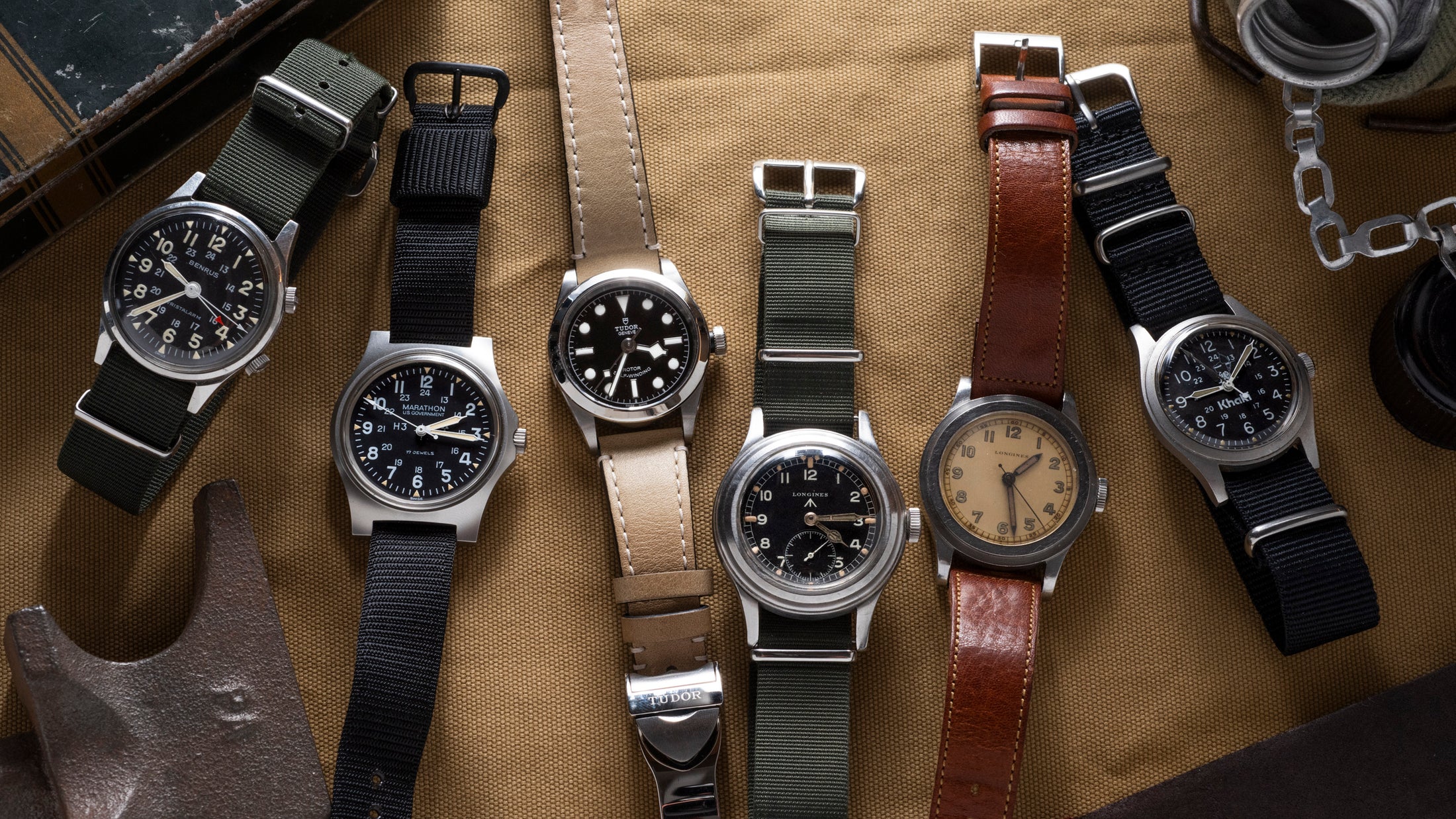Before the First World War, a gentleman carried a pocket watch.
Then, as it became apparent that checking one’s pocket watch while trying to fire one’s rifle, while trying to coordinate artillery fire, while trying to signal, while trying to dodge incoming attacks, was cumbersome, soldiers began affixing rudimentary lugs to their pocket watches and wearing them on their wrists. Soon, watch companies adapted their production and began making dedicated wristwatches.
These were functionally the earliest ‘field’ watches — watches meant for use in, well, the field. Advertisements from the First World War show timepieces with shrapnel guards, luminous radium paint, and strong steel cases. By today’s standards, such timepieces are positively dainty — better suited for the opera than the battlefield. But these are indeed the watches that won the War, helping to coordinate fire, time attacks, and measure the long days and years spent in the trenches.
Today, the lines between dedicated ‘field’ watches and many other types of everyday watches have become blurred. While certain companies such as Marathon still specialize in field watches for military contracts (as well as civilian sales), others simply produce hard-wearing pieces that make for excellent field watches regardless of original design remit. Other modern models are descended from genuine field watches.
What even is a field watch, anyway? Generally, the greater watch industry defines one as a time-only (or time-and-date) watch with a robust case, a hardy movement (irrespective of type, whether quartz or mechanical), a subdued aesthetic, a highly legible dial, and a simple strap or bracelet (generally the former). Basically, think “military” or “tactical,” as that’s what field watches were originally designed for: a life in the field, on the wrist of a soldier.
As field watches are generally fairly simple contraptions by the standards of haute horlogerie, new models (especially from smaller ‘microbrands’) are eminently affordable. Today, we thought we’d bring you a smattering of the classics — some of our favorites from the mid-20th century — along with the occasional more modern watch. The next time you step out for some time in the great outdoors, consider strapping one of these on.
Hamilton Khaki Field 'Brigade Quartermaster' ($1,250)

Hamilton Khaki Field 'Brigade Quartermaster' - IN THE SHOP
In addition to its government-issued field watches from the Vietnam War, Hamilton also produced thousands of similar pieces for various outdoor retailers, which put their own logos on the dial. One of the rarest is this one from Brigade Quartermasters, a now-defunct mail order business. Hand-wound and beautifully sized at 34mm, it’ll fit on any wrist.
Tudor Black Bay 36 ($2,250)

Tudor Black Bay 36 - IN THE SHOP
While it could be argued that Tudor has a dedicated field watch line in the form of the Ranger, the Black Bay 32, 36, and 41 clearly take much of their design language from the 4-digit Tudor references of the mid-20th century — such as the 7909 — which were certainly used in the field. This Black Bay 36, with its automatic movement and highly legible dial, is a modern classic.
Marathon/Gallet Military Watch ($2,300)

Marathon/Gallet Military Watch - IN THE SHOP
Marathon still makes field watches to military specifications, but there’s something about this classic steel version from the 1980s, with its hand-wound movement and tritium dial, that sets our hearts aflutter. Measuring 36mm and signed with “U.S. Government” on the dial — as well as its procurement numbers on the caseback — it’s a serious piece of kit.
Benrus Wrist Alarm 'Bullitt' ($3,550)

Benrus Wrist Alarm 'Bullitt' - IN THE SHOP
Benrus, an American firm, built thousands of military watches for U.S. forces during the Vietnam War. Its Reference 3021, which includes an alarm function, is atypical for a field watch, but serves to differentiate it from a sea of similar fare from the 1960s and 1970s. This fun and useful complication aside, it's all business, with a black military dial and ‘dart’ lume plots.
IWC 'WWW' ($4,500)

IWC 'WWW' - IN THE SHOP
Measuring 35mm and dating to the tail end of the Second World War, this I.W.C. ‘W.W.W.’ is one of the famed ‘Dirty Dozen’ watches produced by 12 Swiss manufacturers for the British government. At just 6,000 pieces, it saw relatively low production numbers, and its tritium lume plots and snap-back caseback are indicative of the era in which it was produced.
Longines Greenlander 'WWW' ($5,950)

Longines Greenlander 'WWW' - IN THE SHOP
Like the aforementioned I.W.C. field watch, the Longines Reference 23088 ‘Greenlander’ was one of the ‘W.W.W.’ pieces produced for the British military at the end of the Second World War. The Longines version is distinct, with a wide bezel and ‘cathedral’ handset not seen on other ‘Dirty Dozen’ watches; less than 5,000 pieces were produced, making it fairly rare.
Longines Tre-Tacche ($11,750)

Longines Tre-Tacche - IN THE SHOP
The Longines ‘Tre-Tache’ — so called for its caseback with three notches — is the prototypical field watch of the 1930s and 1940s. Produced in several sizes, the larger 35mm version is much rarer than its 30mm and 32mm brethren. This example, delivered to South Africa in 1941 and featuring excellent patina, is a wonderful example of Wartime watchmaking.
Omega Railmaster ($15,700)

Omega Railmaster - IN THE SHOP
The Railmaster, part of the original trilogy that included the Speedmaster and Seamaster, is one of Omega’s most beautiful designs. Meant as a highly anti-magnetic field watch, its good looks and large 38mm stainless steel case lend it a highly versatile quality, while its expanding flat-link bracelet will certainly endear it to collectors.












